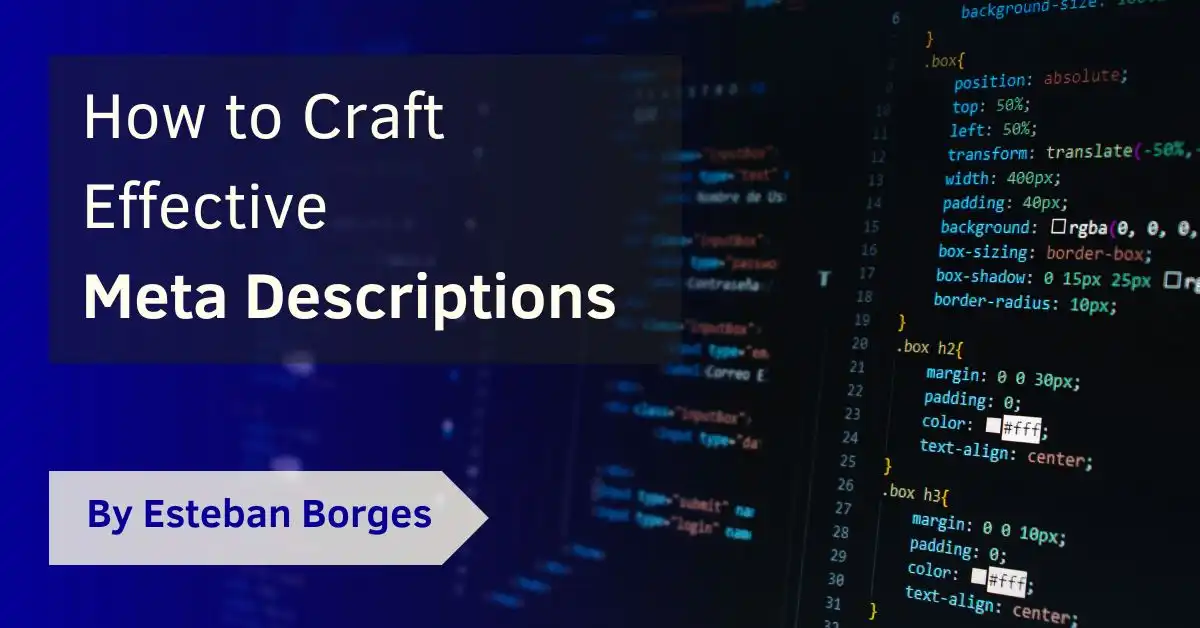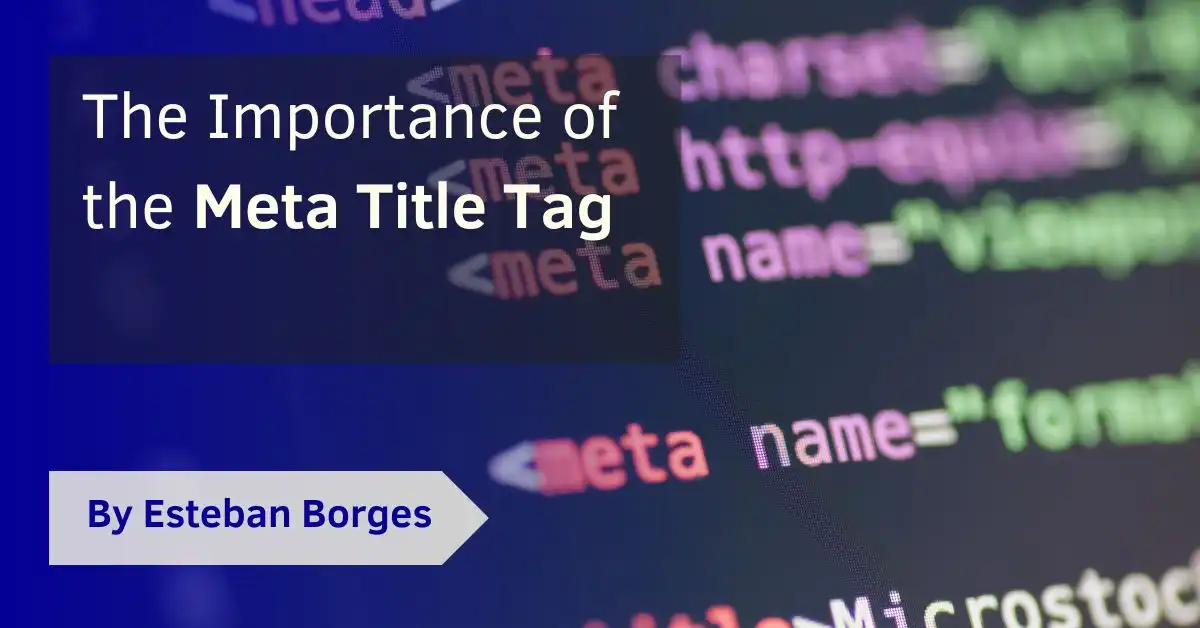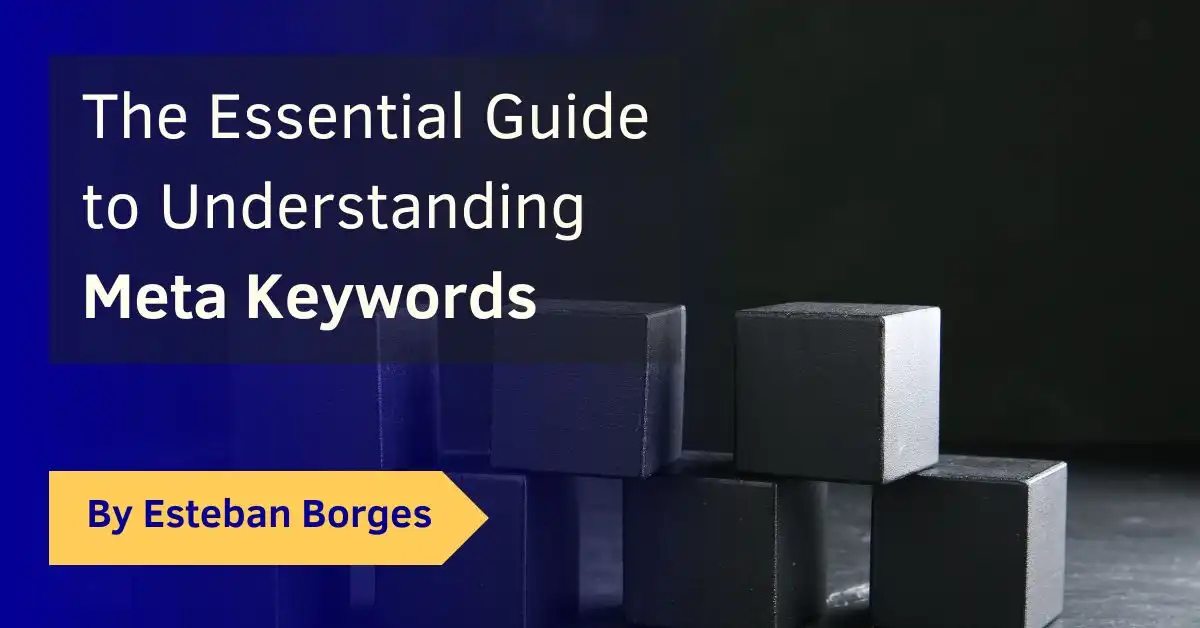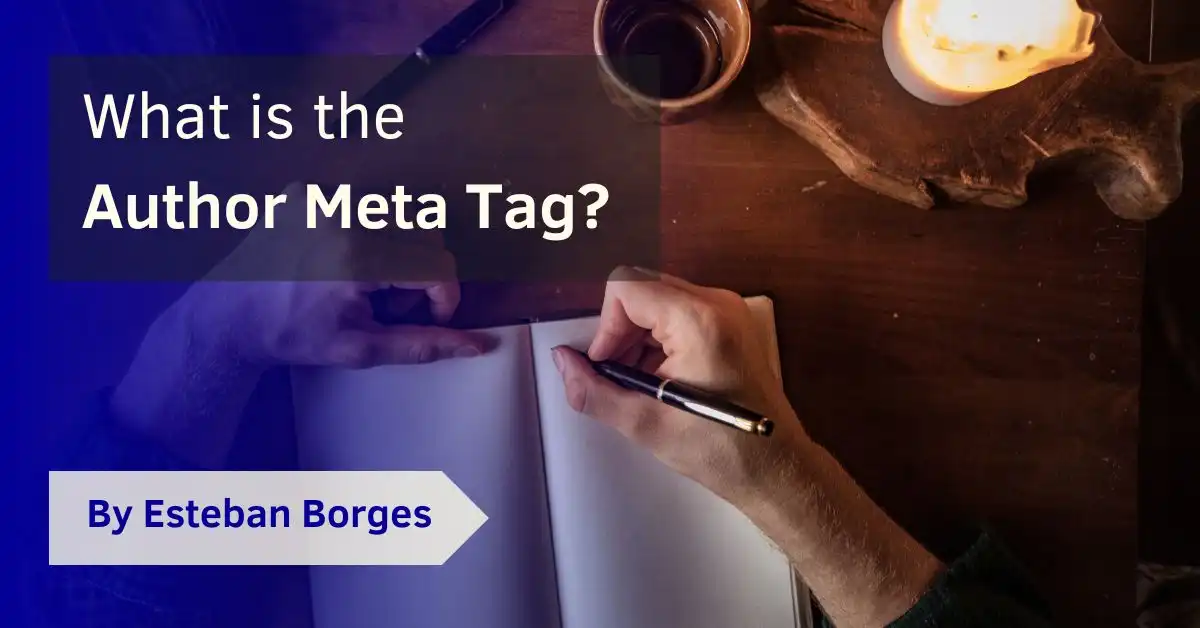How to Craft Effective Meta Descriptions
In today’s digital age, optimizing your website for search engines is crucial. Two key aspects of this process are conducting a thorough Technical SEO Audit and devising an effective Content Strategy. But beyond these, another element that plays a significant role in your site’s visibility and click-through rates is the meta description. While seemingly simple, crafting an effective meta-description requires a balance of brevity, relevancy, and persuasion.
This guide delves into the intricacies of meta descriptions, their role in SEO, and best practices for creating them. Let’s begin the exploration.
Table of Contents
What Exactly is a Meta Description?
A meta description, in essence, is an HTML attribute that succinctly encapsulates the content of a webpage. Generally displayed beneath the URL in search engine results, this “SEO description”, alongside the Meta Title Tags, serves as a snapshot of the page’s content.
While not a direct determinant in Google’s ranking algorithm, they impact click-through rates (CTR), which can have a secondary influence on your website’s search engine ranking. While seemingly simple, crafting an effective meta-description requires a balance of brevity, relevancy, and persuasion. This guide delves into the intricacies of meta descriptions, their role in SEO, and best practices for creating them. Let’s begin the exploration.
Decoding Meta Description Tags
Meta description tags exist within the HTML framework of a webpage. They’re nestled in the <head> section, usually adhering to the format: <meta name="description" content="This is an example meta description.">
Ideal Length for Meta Descriptions
Ideally, a meta description falls within the range of 50-160 characters. Striking the balance between brevity and information-rich is crucial to prompt users to click on your link.
What Can a Meta Description Incorporate?
A meta description should weave in your target keywords, persuasive language, and a succinct overview of the webpage’s content. The goal is to provide a quick preview that incites users to click your link when it emerges in search results.
Meta Description Examples
Meta descriptions require a careful balance of keywords, concise information, and persuasive language to encourage click-throughs. Let’s look at a few examples that effectively encapsulate these elements:
- E-commerce Product Page:
- Meta Description: “Discover the latest XYZ smartphone with an advanced AI camera, longer battery life, and seamless performance. Order now for free shipping!”
- Blog Post about Healthy Eating:
- Meta Description: “Explore our comprehensive guide on healthy eating. Packed with diet plans, nutritious recipes, and tips for a balanced lifestyle. Start your wellness journey today!”
- Local Business (Pizza Restaurant):
- Meta Description: “Craving authentic Italian pizza in [City Name]? Visit XYZ Pizzeria! Fresh ingredients, secret family recipes, and a cozy atmosphere await you. Book a table now.”
- Software-as-a-Service (SaaS) Landing Page:
- Meta Description: “Streamline your workflow with XYZ Software! Experience top-notch features like real-time collaboration, cloud storage, and robust security. Start your free trial today!”
- Online Course Landing Page:
- Meta Description: “Master Python programming with our comprehensive online course. Interactive lessons, expert instructors, and a thriving learner community. Enroll now and code your way to success!”
The Function of Meta Description on a Webpage
On the actual webpage, the meta description remains invisible. It plays a behind-the-scenes role, supplying search engines with the page details, which in turn, fill out search results, as you can see from the following screenshot:
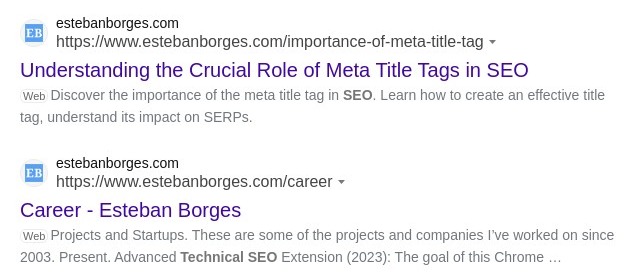
Meta Description Generation with AI
In the rapidly evolving digital world, artificial intelligence (AI) has found numerous applications, including content creation and optimization. A powerful tool in this sphere is OpenAI’s ChatGPT, which can be harnessed to generate effective meta descriptions.
Using AI like ChatGPT for generating meta descriptions not only saves time but can also produce optimized, unique, and engaging descriptions that appeal to users and search engines alike. The process involves providing the AI with a prompt that describes your intent. ChatGPT then generates a response based on the provided prompt.
Here’s an example of how to construct a prompt for ChatGPT:
- Prompt: “Generate a meta description for a webpage about ‘The Ultimate Guide to Vegan Baking’. The page includes various vegan baking recipes, tips for vegan baking, and the health benefits of vegan baked goods.”
Based on this prompt, ChatGPT might generate a meta description like:
- “Dive into our Ultimate Guide to Vegan Baking, a treasure trove of delicious recipes, handy tips, and health benefits. Begin your vegan baking journey today!”
Using Advanced AI Prompts to Generate SEO Descriptions
Let’s explore another example of using ChatGPT to generate a meta description, this time with a specific character limit and keyword considerations:
- Prompt: “Generate a meta description for a blog post titled ‘Innovative Home Gardening Techniques’. The post discusses various modern gardening techniques, benefits of home gardening, and how to get started. The description should not exceed 160 characters and should include the keywords ‘home gardening’, ‘innovative techniques’, and ‘getting started’.”
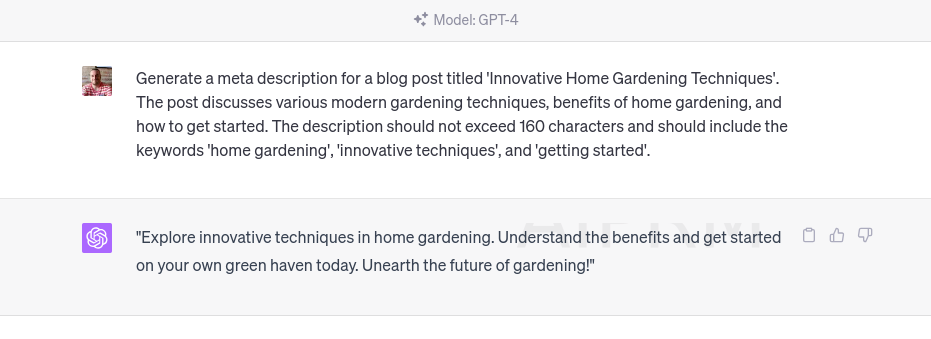
Using this prompt, ChatGPT might create a meta description like:
- “Explore ‘innovative techniques’ in ‘home gardening’ and reap the rewards. Learn about the benefits and steps for ‘getting started’ today!” (129 characters)
Important: AI-generated content should ideally undergo human review for final tweaks and to ensure it aligns with your brand’s voice and style.
Practices to Evade in a Meta Description
- Avoid duplication of meta descriptions across different pages
- Avoid exceeding the suggested length (60 characters max)
- Avoid keyword stuffing (repeating the same keyword over and over)
- If you employ AI to generate meta descriptions, it’s crucial to double-check for potential duplicate content. Also, verify that the generated text accurately represents your page’s purpose and resonates with its overall message.
Necessity of a Meta Description
Though not obligatory, a well-articulated meta-description is strongly recommended. It can enhance the CTR of your webpage, better the user experience, and potentially augment your site’s SEO performance.
Without a doubt, meta descriptions still hold importance. Although not a direct ranking factor, they’re integral for enticing users to select your webpage from the search results, indirectly enhancing your search engine ranking
Do I Need a Meta Description on Every Page?
The ideal scenario is a yes. Every webpage on your site should boast a unique meta description. This not only assists search engines in understanding the content of each page but also grants users valuable insights into what to anticipate when they click on your webpage.
Summary of Meta Description Best Practices
In this segment, let’s recap the key practices for creating effective meta descriptions that can potentially boost your SEO:
- Keep It Brief, Yet Descriptive: Meta descriptions should ideally fall within a 50-160 character range. Pack your description with valuable information but maintain brevity.
- Use Targeted Keywords: Weave in relevant keywords that you want your page to rank for. This can enhance the visibility of your webpage in search results.
- Make Each Description Unique: Avoid duplicating meta descriptions across different web pages. Each description should be tailored to the specific content of the page.
- Write for the User: The description should be compelling and enticing to the user, urging them to click through to the website.
- Avoid Keyword Stuffing: While including keywords is essential, overdoing it can lead to penalties from search engines. Ensure a natural, user-friendly keyword integration.
- Accuracy is Essential: The meta description must accurately reflect the webpage content. Misleading descriptions can lead to higher bounce rates.
- Meta Descriptions for All Pages: Each page of your website should have its own unique meta description to aid search engines and provide users with a preview of the page content.
Conclusion
Meta descriptions are a pivotal facet of your SEO strategy. They offer a brief preview of your webpage content and can drastically influence your webpage’s click-through rates. Hence, invest effort into crafting engaging, unique, and succinct meta descriptions for your web pages.
For more comprehensive insights on this topic, check these resources:
